Se proyecta que el tamaño del mercado de simuladores de pacientes alcance los 1230 millones de dólares estadounidenses para 2031, frente a los 570 millones de dólares estadounidenses de 2023. Se espera que el mercado registre una tasa de crecimiento anual compuesta (TCAC) del 11,4 % entre 2023 y 2031. Es probable que los crecientes avances tecnológicos en simuladores de pacientes sigan siendo una tendencia clave en el mercado.
Análisis del mercado de simuladores de pacientes
Los factores clave que impulsan el crecimiento del mercado son la creciente demanda de simuladores de pacientes para la formación de profesionales médicos y el aumento de la demanda de métodos de tratamiento mínimamente invasivos. Sin embargo, se prevé que el elevado coste de los simuladores de pacientes frene el mercado durante el período de pronóstico. Además, la creciente concienciación sobre la formación en simulación ha generado oportunidades de crecimiento para el mercado de simuladores de pacientes durante el próximo período de pronóstico.
Descripción general del mercado de simuladores de pacientes
La simulación de pacientes permite a profesionales de la salud y estudiantes desarrollar las habilidades técnicas y profesionales necesarias en sus campos de estudio sin los riesgos inherentes al manejo de pacientes humanos. Los modelos de entrenamiento no solo permiten a los estudiantes adquirir experiencia práctica, sino que también ofrecen una excelente visualización. Los simuladores de alta fidelidad detectan y muestran pulsos, respiración, ritmo cardíaco y presión arterial en equipos médicos reales, al igual que en pacientes reales. Estas características despiertan las emociones del alumno y proporcionan un entorno de aprendizaje realista, permitiéndole sumergirse en el ejercicio y tratar al paciente simulado como si fuera uno real. El uso de herramientas de entrenamiento basadas en simulación en cirugía está en rápido aumento y ha demostrado ofrecer alternativas de entrenamiento favorables que permiten mejorar las habilidades quirúrgicas a pesar de las presiones laborales. La función principal de la simulación es capacitar a quienes se preparan o trabajan en la atención médica. El entrenamiento basado en simulación puede transformar un equipo de expertos en un equipo experto. Por lo tanto, el creciente uso de simuladores en hospitales docentes, escuelas de enfermería, entrenamiento médico militar y centros de formación paramédica con fines de capacitación está impulsando el mercado de simuladores de pacientes.
Personalice este informe según sus necesidades
Obtendrá personalización en cualquier informe, sin cargo, incluidas partes de este informe o análisis a nivel de país, paquete de datos de Excel, así como también grandes ofertas y descuentos para empresas emergentes y universidades.
Mercado de simuladores de pacientes: perspectivas estratégicas

-
Obtenga las principales tendencias clave del mercado de este informe.Esta muestra GRATUITA incluirá análisis de datos, desde tendencias del mercado hasta estimaciones y pronósticos.
Impulsores y oportunidades del mercado de simuladores de pacientes
Aumento de la demanda de tratamientos mínimamente invasivos
Un procedimiento médico mínimamente invasivo generalmente se realiza introduciendo el dispositivo en el cuerpo a través de la piel, una cavidad corporal o una abertura anatómica, pero con el menor daño posible a estas estructuras. En los últimos años, se han logrado mejoras significativas en el tratamiento de las enfermedades cardiovasculares. Sin embargo, estos procedimientos médicos complejos requieren una amplia experiencia y conocimientos técnicos. El tratamiento complejo de las enfermedades cardiovasculares se simplifica con la ayuda de simuladores. El sistema puede producir modelos vasculares 3D realistas segmentados a partir de conjuntos de datos del paciente, que incluyen un corazón latiendo, y proporciona un cálculo de fuerza en tiempo real y un módulo de retroalimentación de fuerza para simuladores de pacientes. Además, la cirugía mínimamente invasiva (CMI) avanzada, que es la cirugía asistida por robot, está ganando cada vez más aceptación. Existe una creciente necesidad de formar a residentes en este tipo de cirugía. La creciente demanda de CMI está impulsando el crecimiento del mercado de simuladores de pacientes.
Aumento de la conciencia sobre la educación mediante simulación
Distintas organizaciones realizan diversas actividades de concientización sobre la simulación de pacientes. Por ejemplo, en 2007, se fundó la Sociedad Latinoamericana de Simulación en Salud (ALASIC) con la idea de fomentar la colaboración y el trabajo en red dentro del continente entre miembros de diferentes países de América del Norte, Central y del Sur. Considerando la importancia de la seguridad del paciente, muchas universidades también están abriendo centros de simulación de pacientes. Constantemente se están inaugurando centros de simulación en salud en Estados Unidos y a nivel mundial.
Los centros de simulación cuentan con médicos especializados, maniquíes avanzados y computarizados de todas las edades, y simulan condiciones para ayudar a estudiantes y profesionales de la salud a practicar habilidades clínicas. Estos centros de capacitación también fortalecerán las habilidades de comunicación y toma de decisiones, y brindarán capacitación práctica en diagnóstico, tratamiento y atención médica. Se estima que proporcionarán más de 50,000 horas de aprendizaje práctico a casi 20,000 estudiantes que trabajan o desarrollan carreras en las ciencias de la salud. Por lo tanto, se prevé que la creciente concienciación sobre la educación mediante simulación brinde una oportunidad para el mercado de la simulación de pacientes.
Análisis de segmentación del informe de mercado de simuladores de pacientes
Los segmentos clave que contribuyeron a la derivación del análisis del mercado de simuladores de pacientes son el producto y el usuario final.
- Según el producto, el mercado de simuladores de pacientes se segmenta en simuladores de pacientes adultos, simuladores de bebés y simuladores de parto. El segmento de simuladores de pacientes adultos tuvo una mayor participación de mercado en 2023.
- Según el usuario final, el mercado de simuladores de pacientes se segmenta en institutos académicos, hospitales y organizaciones militares. El segmento de institutos académicos tuvo una mayor participación de mercado en 2023.
Análisis de la cuota de mercado de simuladores de pacientes por geografía
El alcance geográfico del informe del mercado de simuladores de pacientes se divide principalmente en cinco regiones: América del Norte, Asia Pacífico, Europa, Medio Oriente y África, y América del Sur y Central.
En Norteamérica, Estados Unidos es el mayor mercado de simuladores de pacientes. Diversos fabricantes e instituciones de formación han utilizado simuladores de pacientes para impartir formación. Por ejemplo, el Centro de Simulación de Johns Hopkins Medicine es un centro de formación médica moderno y plenamente acreditado que utiliza diversas técnicas de simulación, como simulación computarizada, realidad virtual, entrenadores de tareas, simulación de pacientes humanos y pacientes y docentes auxiliares estandarizados. Mejorar la seguridad en la atención al paciente es el principal objetivo del centro. Estas instalaciones de formación mejoran la comodidad del personal clínico y su capacidad para responder ante emergencias, además de contribuir a mejorar la seguridad del paciente.
Se anticipa que las estadísticas mencionadas anteriormente sobre muertes causadas por errores médicos, junto con las medidas para incluir el uso de simuladores de pacientes con fines de capacitación, impulsarán la demanda de simuladores de pacientes en los EE. UU. durante el período de pronóstico a un ritmo significativo.
Perspectivas regionales del mercado de simuladores de pacientes
Los analistas de The Insight Partners han explicado detalladamente las tendencias regionales y los factores que influyen en el mercado de simuladores de pacientes durante el período de pronóstico. Esta sección también analiza los segmentos y la geografía del mercado de simuladores de pacientes en América del Norte, Europa, Asia Pacífico, Oriente Medio y África, y América del Sur y Central.
Alcance del informe de mercado de simuladores de pacientes
| Atributo del informe | Detalles |
|---|---|
| Tamaño del mercado en 2023 | US$ 0,57 mil millones |
| Tamaño del mercado en 2031 | 1.230 millones de dólares estadounidenses |
| CAGR global (2023-2031) | 11,4% |
| Datos históricos | 2021-2022 |
| Período de pronóstico | 2024-2031 |
| Segmentos cubiertos |
Por producto
|
| Regiones y países cubiertos |
América del norte
|
| Líderes del mercado y perfiles de empresas clave |
|
Densidad de actores del mercado de simuladores de pacientes: comprensión de su impacto en la dinámica empresarial
El mercado de simuladores de pacientes está creciendo rápidamente, impulsado por la creciente demanda de los usuarios finales debido a factores como la evolución de las preferencias de los consumidores, los avances tecnológicos y un mayor conocimiento de los beneficios del producto. A medida que aumenta la demanda, las empresas amplían su oferta, innovan para satisfacer las necesidades de los consumidores y aprovechan las tendencias emergentes, lo que impulsa aún más el crecimiento del mercado.

- Obtenga una descripción general de los principales actores clave del mercado de simuladores de pacientes
Noticias y desarrollos recientes del mercado de simuladores de pacientes
El mercado de simuladores de pacientes se evalúa mediante la recopilación de datos cualitativos y cuantitativos tras la investigación primaria y secundaria, que incluye importantes publicaciones corporativas, datos de asociaciones y bases de datos. A continuación, se enumeran algunos de los avances en el mercado de simuladores de pacientes:
- GigXR Inc. y CAE Healthcare se asociaron para mejorar la eficiencia y la eficacia de la simulación clínica. La colaboración entre GigXR y CAE Healthcare optimiza la capacidad de implementar y gestionar la simulación multimodal para facultades de medicina, escuelas de enfermería, sistemas hospitalarios, personal de primera respuesta y el gobierno, abarcando modalidades analógicas, inmersivas y digitales que permiten crear planes de estudio completos. (Fuente: CAE Healthcare, sitio web de la empresa, enero de 2024)
- Laerdal Medical y SimX se asocian para ampliar el impacto de la formación en simulación médica mediante RV. Gracias a esta alianza, Laerdal se convertirá en el principal distribuidor de la plataforma de simulación de realidad virtual SimX para hospitales, servicios de emergencias médicas (SME) y clientes gubernamentales en EE. UU. y Canadá. (Fuente: Laerdal Medical, sitio web de la empresa, junio de 2022)
Informe de mercado sobre simuladores de pacientes: cobertura y resultados
El informe "Tamaño y pronóstico del mercado de simuladores de pacientes (2021-2031)" ofrece un análisis detallado del mercado que abarca las siguientes áreas:
- Tamaño del mercado de simuladores de pacientes y pronóstico a nivel global, regional y nacional para todos los segmentos clave del mercado cubiertos bajo el alcance
- Tendencias del mercado de simuladores de pacientes, así como dinámicas del mercado, como impulsores, restricciones y oportunidades clave.
- Análisis detallado PEST/de las cinco fuerzas de Porter y FODA
- Análisis del mercado de simuladores de pacientes que cubre las tendencias clave del mercado, el marco global y regional, los principales actores, las regulaciones y los desarrollos recientes del mercado.
- Análisis del panorama industrial y de la competencia que abarca la concentración del mercado, el análisis de mapas de calor, los actores destacados y los desarrollos recientes del mercado de simuladores de pacientes.
- Perfiles detallados de empresas
- Análisis histórico (2 años), año base, pronóstico (7 años) con CAGR
- Análisis PEST y FODA
- Tamaño del mercado, valor/volumen: global, regional y nacional
- Industria y panorama competitivo
- Conjunto de datos de Excel
Informes recientes
Testimonios
Razón para comprar
- Toma de decisiones informada
- Comprensión de la dinámica del mercado
- Análisis competitivo
- Información sobre clientes
- Pronósticos del mercado
- Mitigación de riesgos
- Planificación estratégica
- Justificación de la inversión
- Identificación de mercados emergentes
- Mejora de las estrategias de marketing
- Impulso de la eficiencia operativa
- Alineación con las tendencias regulatorias






















 Obtenga una muestra gratuita para - Mercado de simuladores de pacientes
Obtenga una muestra gratuita para - Mercado de simuladores de pacientes